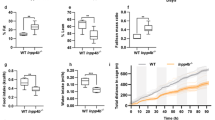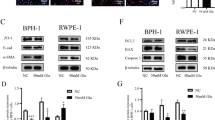Abstract
We examined the effects of anti-six-transmembrane epithelial antigen of the prostate-4 (STEAP4) antibodies on glucose transport in mature adipocytes and determined the mechanism of insulin resistance in obesity. Western blotting was performed to determine STEAP4 expression, to assess translocation of insulin-sensitive glucose transporter 4 (GLUT4), and to measure phosphorylation and total protein content of insulin-signaling proteins. Confocal laser microscopy and flow cytometry were used to detect intracellular reactive oxygen species (ROS) and fluctuations in mitochondrial membrane potential (ΔΨ). ATP production was measured by using a luciferase-based luminescence assay kit. After the application of anti-STEAP4 antibodies at 0.002 mg/mL, adipocytes exhibited reduced insulin-stimulated glucose transport by attenuating the phosphorylation of IRS-1, PI3K (p85), and Akt. The antibodies also potentially increase the level of ROS and decrease cellular ATP production and ΔΨ. In conclusion, (i) STEAP4 regulates the function of IRS-1, PI3K, and Akt and decreases insulin-induced GLUT4 translocation and glucose uptake; (ii) ROS-related mitochondrial dysfunction may be related to a reduced IRS-1 correlation with the PI3K signaling pathway, leading to insulin resistance. These observations highlight the potential role of STEAP4 in glucose homeostasis and possibly in the pathophysiology of type 2 diabetes related to obesity and may provide new insights into the mechanisms of insulin resistance in obesity.
Similar content being viewed by others
References
Alessi DR, Andjelkovic M, Caudwell B, Cron P, Morrice N, Cohen P, Hemmings BA (1996) Mechanism of activation of protein kinase B by insulin and IGF-1. EMBO J15(23):6541–6551
Andjelković M, Jakubowicz T, Cron P, Ming XF, Han JW, Hemmings BA (1996) Activation and phosphorylation of a pleckstrin homology domain containing protein kinase (RAC-PK/PKB) promoted by serum and protein phosphatase inhibitors. Proc Natl Acad Sci U S A93(12):5699–5704
Andjelković M, Alessi DR, Meier R, Fernandez A, Lamb NJ, Frech M, Cron P, Cohen P, Lucocq JM, Hemmings BA (1997) Role of translocation in the activation and function of protein kinase B. J Biol Chem 272(50):31515–31524
Arner P, Stenson BM, Dungner E, Näslund E, Hoffstedt J, Ryden M, Dahlman I (2008) Expression of six transmembrane protein of prostate 2 in human adipose tissue associates with adiposity and insulin resistance. J Clin Endocrinol Metab 93:2249–2254
Boura-Halfon S, Zick Y (2008) Phosphorylation of IRS proteins, insulin action and insulin resistance. Am J Physiol Endocrinol Metab 296(4):E581–E591
Challita-Eid Pia M, Kendall Morrison, Soudabeh Etessami, Zili An, Morrison Karen J, Perez-Villar Juan J, Raitano Arthur B, **ao-Chi Jia, Gudas Jean M, Kanner Steven B, Aya Jakobovits (2007) Monoclonal antibodies to six-transmembrane epithelial antigen of the prostate-1 inhibit intercellular communication in vitro and growth of human tumor xenografts in vivo. Cancer Res 67(12):5798–5805
Chen XH, Zhu C, Ji CB, Zhao YP, Zhang CM, Chen FK, Gao CL, Zhu JG, Qian LM, Guo XR (2010) STEAP4, a gene associated with insulin sensitivity, is regulated by several adipokines in human adipocytes. Int J Mol Med 25(3):361–367
Corvera S, Czech MP (1998) Direct targets of phosphoinositide 3-kinase products in membrane traffic and signal transduction. Trends Cell Biol 8(11):442–446
Dani Qin, Chunzhao Kou, Yuhui Ni, Chunmei Zhang, **gai Zhu, Chun Zhu, Yan** Wang, Guanzhong Zhu, Chunmei Shi, Chenbo Ji, **rong Guo (2010) Monoclonal antibody to six-transmembrane epithelial antigen of the prostate-4 promotes apoptosis and inhibits proliferation and glucose uptake in human adipocytes. Int J Mol Med (accept)
Dani Qin, Chenbo Ji, Chun Zhu, Chunzhao Kou, **rong Guo (2010) STEAP4 antibodies have an effect on preadipocyte reactive oxygen species and mitochondrial membrane potential. Online Chinese Articles.
Ducluzeau PH, Fletcher LM, Vidal H, le Lavil M, Tavaré JM (2002) Molecular mechanisms of insulin-stimulated glucose uptake in adipocytes. Diab Metab 28:85–92
Garcia-Hernandez Mde L, Gray A, Hubby B, Kast WM (2007) In vivo effects of vaccination with six-transmembrane epithelial antigen of the prostate: a candidate antigen for treating prostate cancer. Cancer Res 67(3):1344–1351
Giovannone B, Scaldaferri ML, Federici M, Porzio O, Lauro D, Fusco A, Sbraccia P, Borboni P, Lauro R, Sesti G (2000) Insulin receptor substrate (IRS) transduction system: distinct and overlap** signaling protein. Diab Metab Res Rev 16:434–4
Takahiko Tamura and Joe Chiba (2009) Production of Antibodies againstMultipass Membrane Proteins Expressed in Human Tumor Cells Using Dendritic Cell Immunization. J Biomed Biotechnol 2009:673098.
Khayat ZA, Tong P, Yaworsky K, Bloch RJ, Klip A (2000) Insulin-induced actin filament remodeling colocalizes actin with phosphatidylinositol 3-kinase and GLUT4 in L6 myotubes. J Cell Sci 113(Pt 2):279–290
Kim JA, Wei Y, Sowers JR (2008) Role of mitochondrial dysfunction in insulin resistance. Circ Res 102(4):401–414
Knutson MD (2007) Steap proteins: implications for iron and copper metabolism. Nutr Rev 65(7):335–340
Korkmaz CG, Korkmaz KS, Kurys P, Elbi C, Wang L, Klokk TI, Hammarstrom C, Troen G, Svindland A, Hager GL, Saatcioglu F (2005) Molecular cloning and characterization of STAMP2, an androgen-regulated six transmembrane protein that is overexpressed in prostate cancer. Oncogene 24(31):4934–4945
Lastra G, Whaley-Connell A, Manrique C, Habibi J, Gutweiler AA, Appesh L, Hayden MR, Wei Y, Ferrario C, Sowers JR (2008) Low-dose spironolactone reduces reactive oxygen species generation and improves insulin-stimulated glucose transport in skeletal muscle in the TG(mRen2)27 rat]. Am J Physiol Endocrinol Metab 295(1):E110–E116
Martin SS, Haruta T, Morris AJ, Klippel A, Williams LT, Olefsky JM (1996) Activated phosphatidylinositol 3-kinase is sufficient to mediate actin rearrangement and GLUT4 translocation in 3T3-L1 adipocytes. J Biol Chem 271(30):17605–17608
Maxwell DP, Wang Y, McIntosh L (1999) The alternative oxidase lowers mitochondrial reactive oxygen production in plant cells. Proc Natl Acad Sci USA 96(14):8271–8276
Moldes M, Lasnier F, Gauthereau X, Klein C, Pairault J, Feve B (2001) Tumor necrosis factor -alpha-induced adipose-related protein (TIARP), a cell-surface protein that is highly induced by tumor necrosis factor-alpha and adipose conversion. J Biol Chem 276:33938–33946
Morino K, Petersen KF, Shulman GI (2006) Molecular mechanisms of insulin resistance in humans and their potential links with mitochondrial dysfunction. Diabetes 55(suppl 2):S9–S15
Ohgami RS, Campagna DR, McDonald A, Fleming MD (2006) The Steap proteins are metalloreductases. Blood 108:1388–1394
Okada T, Kawano Y, Sakakibara T, Hazeki O, Ui M (1994) Essential role of phosphatidylinositol 3-kinase in insulin-induced glucose transport and antilipolysis in rat adipocytes. Studies with a selective inhibitor wortmannin. J Biol Chem 269(5):3568–3573
Park J, Choe SS, Choi AH, Kim KH, Yoon MJ, Suganami T, Ogawa Y, Kim JB (2006) Increase in glucose-6-phosphate dehydrogenase in adipocytes stimulates oxidative stress and inflammatory signals. Diabetes 55:2939–2949
Sears DD, Hsiao G, Hsiao A, Yu JG, Courtney CH, Ofrecio JM, Chapman J, Subramaniam S (2009) Mechanisms of human insulin resistance and hiazolidinedione-mediated insulin sensitization. Proc Natl Acad Sci USA 106:18745–18750
Weiner LM, Carter P (2005) Tunableantibodies. Nat Biotechnol 23:556–557
Wellen KE, Fucho R, Gregor MF, Furuhashi M, Morgan C, Lindstad T, Vaillancourt E, Gorgun CZ, Saatcioglu F, Hotamisligil GS (2007) Coordinated regulation of nutrient and inflammatory responses by STAMP2 is essential for metabolic homeostasis. Cell 129:537–548
Zhang CM, Chi X, Wang B, Zhang M, Ni YH, Chen RH, Li XN, Guo XR (2008) Downregulation of STEAP4, a highly-expressed TNF-alpha inducible gene in adipose tissue, is associated with obesity in humans. Acta Pharmacol Sin 29(5):587–592
Author information
Authors and Affiliations
Corresponding authors
Additional information
Dani Qin and **-gai Zhu contributed equally to this work
Rights and permissions
About this article
Cite this article
Qin, Dn., Zhu, Jg., Ji, Cb. et al. Monoclonal antibody to six transmembrane epithelial antigen of prostate-4 influences insulin sensitivity by attenuating phosphorylation of P13K (P85) and Akt: Possible mitochondrial mechanism. J Bioenerg Biomembr 43, 247–255 (2011). https://doi.org/10.1007/s10863-011-9360-9
Received:
Accepted:
Published:
Issue Date:
DOI: https://doi.org/10.1007/s10863-011-9360-9




